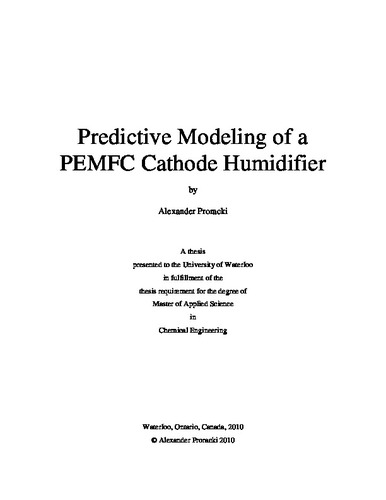Predictive Modeling of a PEMFC Cathode Humidifier
| dc.contributor.author | Proracki, Alexander | |
| dc.date.accessioned | 2010-12-22 21:27:43 (GMT) | |
| dc.date.available | 2010-12-22 21:27:43 (GMT) | |
| dc.date.issued | 2010-12-22T21:27:43Z | |
| dc.date.submitted | 2010 | |
| dc.identifier.uri | http://hdl.handle.net/10012/5690 | |
| dc.description.abstract | The durability and performance of commercially available polymer electrolyte membrane fuel cell (PEMFC) technology depends heavily on adequate humidification of the membrane electrode assembly (MEA). Early generation automotive fuel cell stacks will likely rely on an external humidification process based on gas-to-gas membrane planar humidifiers to humidify the inlet cathode stream. The membrane-based humidifier systems allow the reactants to receive recycled heat and moisture from the cathode outlet stream. The objective of this thesis is to develop a flexible, computer-based simulation tool that can be used to aid in the design of these planar humidifier systems. The simulation is based on fundamental mass transfer concepts and experimental membrane behaviour based on literature results. It was determined that the mass transfer resistance through the membrane is several orders of magnitude higher than the resistance contributed by the gas diffusion media (GDM) and thus the mass transfer resistance through the GDM are not considered. An important point to note is that the Schroeder’s Paradox observed in perfluorosulfonic acid (PFSA) membranes implies that membranes in contact with liquid water will exhibit higher mass transfer than membranes in contact with saturated water vapour despite the fact that the water activity in both situations are unity. Initial simulations for which no liquid water was present resulted in a humidifier water transfer rate less than half the rate observed experimentally. Thus it was hypothesized that condensed liquid water was present on the wet-side of the humidifier membrane and as such this work assumes a fraction of the membrane surface is covered by liquid water while the rest of the membrane is exposed to gaseous water concentrations comparable to the bulk channel stream above the GDM. For typical operating conditions the outlet wet-side stream retains 92% of the inlet water content and as such it was hypothesized that constant fractional liquid water coverage across the membrane could be assumed. Later simulations confirmed the validity of this hypothesis. Six models of water coverage estimation were derived using least squares and factorial design methods. The models were compared however no single method was determined to be superior for all situations as the methods exhibit similar sums of squared error. | en |
| dc.language.iso | en | en |
| dc.publisher | University of Waterloo | en |
| dc.subject | humidifier | en |
| dc.subject | pemfc | en |
| dc.subject | fuel cell | en |
| dc.subject | simulation | en |
| dc.subject | chemical engineering | en |
| dc.title | Predictive Modeling of a PEMFC Cathode Humidifier | en |
| dc.type | Master Thesis | en |
| dc.pending | false | en |
| dc.subject.program | Chemical Engineering | en |
| uws-etd.degree.department | Chemical Engineering | en |
| uws-etd.degree | Master of Applied Science | en |
| uws.typeOfResource | Text | en |
| uws.peerReviewStatus | Unreviewed | en |
| uws.scholarLevel | Graduate | en |

